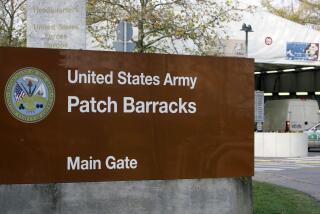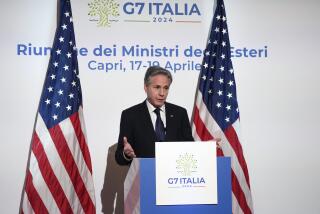U.S. Policy: Don’t Publicize Anonymous Bomb Threats
WASHINGTON — The State Department did not inform American travelers in Europe of a reported plan to bomb a Pan American World Airways jet both because intelligence experts judged the anonymous informant to be a crank and because U.S. policy is to avoid publicizing such warnings, senior officials said Thursday.
Largely for fear of causing panic on the basis of threats that often turn out to be unfounded, the federal government has adopted a policy of concentrating on foiling terrorist attacks instead of warning the public about them, the officials said.
“Our focus has been on alerting those who are responsible for security arrangements,” State Department spokeswoman Phyllis Oakley said. “We want to alert those people who can do something about the threat . . . (air) carriers and airport security personnel.”
“We don’t normally publicize security alerts,” said Robert Buckhorn, a spokesman for the Federal Aviation Administration. “There’s no public outlet--nor should there be.”
“We get dozens of threats each day,” added an official who spoke on condition he not be quoted by name. “We’d bring business to a halt if we issued warnings after all of them.”
An unidentified man telephoned the U.S. Embassy in Helsinki, Finland, on Dec. 5 and warned that terrorists planned to set off a bomb aboard a Pan Am flight from Frankfurt to New York, officials said. On Wednesday, a Pan Am flight that originated in Frankfurt crashed in Scotland, killing all 258 aboard, and British authorities said they are investigating sabotage as a possible cause.
U.S. intelligence experts assessed the Helsinki warning and “decided that it was without foundation,” a senior State Department official said.
Another official said that the caller may have been a man who has offered similar warnings in the past that were later judged unfounded--”a crank,” he said.
And the Finnish Foreign Ministry said authorities in Helsinki had identified the caller as an Arab resident of the country who has made several bomb threats, and that “in the investigation so far, no direct connection has been found between the Arab living in Finland and the air accident in question,” the Associated Press reported.
Nevertheless, the State Department took the warning seriously enough to inform Pan Am, the West German government and the Federal Aviation Administration, which issued a formal “security bulletin” alerting airlines to the threat.
Asked whether the government should have warned travelers that a threat had been reported against Pan Am, White House spokesman Marlin Fitzwater said that the issue “should be considered.”
“I think that certainly will be looked at,” Fitzwater told reporters.
But other officials said they knew of no review of the policy and said they believe that notifying the public of a threat is rarely a good idea.
“There are other things you can do,” said Buckhorn. “In some security cases, airlines have canceled flights.”
In the case of the Helsinki warning, Pan Am spokesman Pamela Hanlon said that the airline did take extra security precautions, but she refused to provide any details. She noted that the FAA’s security alert, issued earlier this month, carried a restriction against publicizing the warning: “The information in this bulletin is solely for the use of U.S. carriers and airport security personnel and may not be further disseminated without the specific approval of the director of civil aviation security.”
President-elect George Bush, who was chairman of a Reagan Administration task force on terrorism, told reporters that he plans to follow the current policy of not publicizing threats.
“When you are dealing with intelligence--which can be an unsubstantiated threat, can be a crackpot phone call, or it can be a real warning--what you’ve got to do is evaluate that intelligence,” Bush said. “Sometimes by going public . . . you give undue attention to what the terrorist wants to call attention to. And so often it’s best to handle these matters by aborting the threat.
“But if you had hard evidence that a specific flight was going to be threatened or that the threat could not be contained, clearly you would want to serve the public good by notifying people,” he added.
The State Department sent a cable warning of the possible attack to many of its diplomatic posts Dec. 9, officials said. But the primary purpose of the message was to inform officials responsible for security and intelligence, not to warn State Department personnel against flying on Pan Am, they said.
In fact, few State Department officials abroad knew of the warning, and at least three were aboard Pan Am Flight 103 when it crashed. Officials said that the U.S. ambassador to Lebanon, John McCarthy, reportedly planned to be on the plane but missed a connecting flight.
American personnel in Moscow were warned of the apparent threat because a notice was posted in the U.S. Embassy snack bar, but that was the only known case of such wide dissemination of the warning.
Pentagon officials said it also appears that few if any U.S. military men and women in West Germany had been alerted to the possible threat, and U.S. Ambassador to Britain Charles H. Price II reported that a total of 49 service personnel were on the flight.
L. Paul Bremer, the State Department’s chief of counterterrorism, issued a statement Thursday evening noting that U.S. diplomatic facilities abroad have received 87 telephone threats of all kinds during the last three months alone.
However, “the vast majority of these were made anonymously against specific embassies or individual employees within an embassy,” Bremer said. “In almost every case, no attempt was made to carry out the threat.”
Bremer did not say how many of the threats were made against airliners or other civilian, non-U.S. government targets. He did not respond to a request for that information.
But he said that the Dec. 5 call was not the first time that the State Department has received a tip that a bomb might be planted aboard a passenger jet.
“In fact, ever since this method was tried and thwarted on an El Al plane in London two years ago, we’ve had--a number of times--people come to us saying that someone in an unsuspecting way is going to carry a bomb on a plane,” he said in a television interview. “So it’s not unusual to have that kind of specificity in a threat.”
Bremer added that since Sept. 1, the State Department’s Bureau of Diplomatic Security has sent 106 separate cables to U.S. missions abroad describing “actual or possible terrorist activities and/or threats.”
Times staff writer Robert C. Toth contributed to this story.
More to Read
Sign up for Essential California
The most important California stories and recommendations in your inbox every morning.
You may occasionally receive promotional content from the Los Angeles Times.











